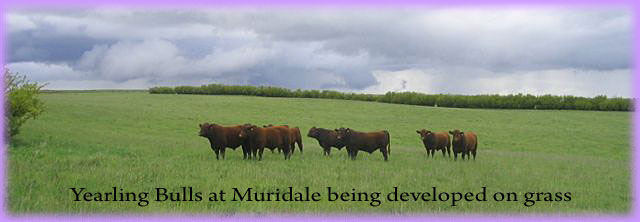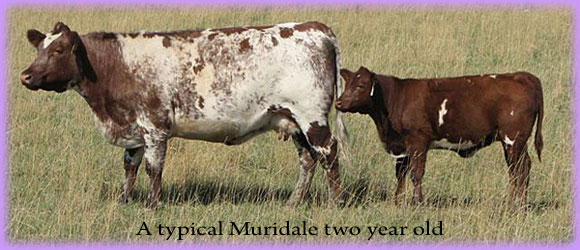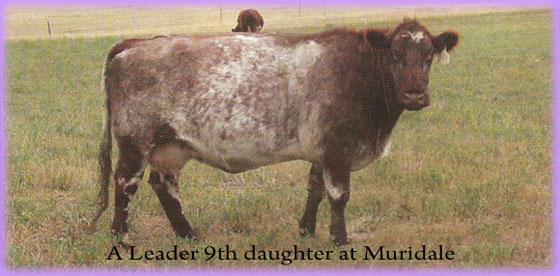The Muri’s Of Muridale Shorthorns
By Grant Alexander
Reprinted from the Fall 2007 Issue of The Canadian Shorthorn Report
One cannot help but notice the gently rolling landscape as you drive towards the Hallonquist district in south west Saskatchewan. It is here that the Muri families have farmed and raised their families for 97 years. Today the fifth generation of Muri’s is being raised since the farm was settled in 1910. This is truly the country of wide open spaces and you sense that you are very close to nature as you travel to the Muri farm.
Andrew Muri was born in Norway and when he first immigrated to North America, he settled at Hope, North Dakota. It was here that he married and his twelve children were born. In 1910, Andrew and his family packed their bags and moved to Canada, homesteading on the present Muri farm, located close to the town of Hallonquist, SK. Sidney Muri farmed with his father and eventually took over the farm when Andrew retired. Ivan, in turn farmed with his father, and eventually took over the farm when Sidney retired. Today, Ivan and Mary Muri, and their son Scot and his wife Joni, live on the original homestead farm. Russell and Wendy (Ivan and Mary's other son) live 30 miles away close to Swift Current, where Russell is employed at the Agriculture Canada Research Station in the forage research department.
Russell still is actively involved in the Muri operation and he maintains all the heifers from the time they are weaned until their return to the home farm as bred heifers. Ivan and Mary also have two daughters, Betty and Tammy. Both daughters were active in the farming operation and were involved in 4-H while growing up. Both Betty and Tammy were Saskatchewan Lassie Queens and represented the breed at numerous Shorthorn events throughout Western Canada, as well as at the Royal Agricultural Winter Fair in Toronto, ON.
The farm encompasses 3120 acres, which is made up of grain land and hay and pasture land. Ivan, Russell and Scot all own their own land but continue to farm it together. Scot has received organic status on his grain land, and his crops are sold for premiums into the organic marketplace. The pasture land consists of both native grasses as well as tame grasses. The native grasses work very well, especially in the fall, as these grasses retain their protein and energy levels long after they mature and turn brown. The seeded tame pastures consist of a mixture of Meadow Brome and Alfalfa blends, and they are also well suited to the environment in this area of Saskatchewan.
Russell and Wendy have two children, Kathryn and Owen. Kathryn is active in the local light horse 4-H club and Owen is active in the 4-H Beef Club. Scot and Joni have two sons, Casey and Tanner. Both boys are members of the Hallonquist 4-H Beef Club and are actively involved in the farming operation. Casey is also active in the Hallonquist Light Horse 4-H Club. Scot and Joni also raise Australian Shepherd dogs as well as Quarter Horses. Joni is involved in barrel racing and also trains the horses they produce. All the Muri family have been leaders of the Hallonquist 4-H club which was co-founded by Sidney Muri.

On this visit to Muri’s to gather some information for this article, we had a good laugh as we talked about my first visit to their farm. That visit occurred in 1980, and Craig Andrew and myself were traveling home from attending the Calgary Bull Sale. We decided that seeing we were only a few miles from the Muri farm, we would stop in. We drove into the yard, and went to Ivan and Mary’s home. It appeared no one was home. We walked over to a pen of cattle and immediately saw that a cow had got her head stuck under the feed opening on a brand new self feeder. At first we thought the cow was dead as she was flat out on her side with her head twisted up inside the feeder. We jumped over the fence and when we got up to her, we found out that she was still alive but very close to death. Chopped feed had fallen over her nose, so she was not able to breathe. Craig got his hands over her nose to keep the feed from falling any more. I ran around the yard looking for something we could use to get this cow free. The first thing I found was an old axe and headed back to the pen. It took us a considerable amount of time as this axe was extremely dull, however we were able to chop a huge hole in the side of this brand new feeder. The cow finally freed, lay on the ground gasping for air. Eventually she stood up and we realized that this was a tremendous female. I jokingly remarked that we maybe should have left her in the feeder as I was now thinking that this cow would beat us at the World Show in Calgary that July. As predicted, she did beat us, and she was a class winner at the World Show.
Now that we had nearly destroyed a brand new feeder, we thought we had better try to explain our actions. All we could find to write a note on in our vehicle was a paper bag, so we wrote an explanation and put it on the door of the house. We later found out that Scot was at his grandfather’s house in the same yard, and neither of them had heard any of the commotion we had created.
Like many early farmers, Shorthorn cattle were introduced to the farm soon after it was settled. Shorthorns were the dominant beef breed in this area in the early 1900’s. The purebred herd was established by Andrew and Sidney in 1927. The first purebred female was named Imperial Ruby and was bred by in the herd of Linton Suggitt, Imperial, SK. The first purebred bull, Vanguard Chief, arrived the same year and he came from Walsh Land Company, Marquette, MB. The Muri’s still have the original registration papers for these animals as well as for all the other foundation stock that were introduced into the herd. They also have photo albums that contain pictures of all the herd sires used as well as many of the good females that grazed the Muridale pastures. It is interesting to look back and see how the herd has developed over the past 80 years.
Ivan recalls some of the early herd sires that have been influential in the herd since he has been operating the herd. A bull, Glen Lloyd Sage, left many big thick females with good fleshing ability. He weighed 2500 lbs in 1951, an era when smaller framed cattle were becoming the norm. Lonedale Conquest 5th arrived in the early 60’s. He was purchased from the herd of John Morari, Calder, SK and was a son of the imported Kair Conquest. This sire also left many outstanding offspring that were thick and easy fleshing cattle.

In the early 70’s Ivan says he seriously debated introducing a bull from the new European breeds, as he could not find a Shorthorn bull that he thought would continue to advance the herd in the direction he wanted to go. He says that it was fortunate when he saw an ad in the Canadian Shorthorn News that got his attention. This was an ad from dual purpose breeder Harold Patterson’s Valley Crest herd in Milton, ON. In this ad, Harold Patterson mentioned that he was offering for sale a roan dual purpose bull named Valley Crest Barrington Lad. Ivan made a phone call and was able to strike a deal on the bull. He arrived by truck from Ontario and was introduced to the Muridale herd. This bull had an incredible impact on the Muridale herd. Combining the genetics of this bull with the Muri cow herd resulted in many thick, bigger framed females with excellent udders.
In 1982 the Muri’s purchased AF Dividend’s Impact 2nd from Alden Farms, Hamilton, Missouri in the Agribition Shorthorn sale. This bull was a full brother to AF Dividend’s Impact who left an incredible legacy at Schrag Shorthorns in South Dakota. The Muri’s liked Impact 2nd when they saw him, but debated if he was going to develop into a big enough bull to work well with their cow herd. Both Ivan and Scot say that it was a good decision to purchase this bull as he worked extremely well in their herd. Another bull that made a mark on their herd in the 80’s was a home bred bull named Muridale Coyote 15T. Coyote was sired by the Denver Champion, Deer Trail Goliath and this bull sired many well muscled, sound structured offspring.
Two herd sires from Mantua Farms, Powell, Wyoming were used in the early 90’s. MF Savage 0136 and MF Xpress 398 both worked well in the Muridale herd. Ramsholt Reward 30E came from Jim Mouser, Claresholm, AB in the mid 90’s and some of his daughters are still in the herd and they are very good females. A son of 30E, Muridale Chet 20G x, was used at Muridale and then was selected by Deerhorn Farms in Minnesota and Dr. Bert Moore, Fargo, North Dakota to head their herds. Chet left many excellent daughters in the Muri herd. In 1999 the Muri’s purchased Mapleton Mr Gus 930 x from Dr. Bert Moore’s herd in North Dakota. This bull also worked well in their herd, and his legacy is still very evident today.
Today’s herd sires include some very impressive sires. Alta Cedar Ultimate 130K is owned jointly with Munroe Lehne, Amisk, AB. Ultimate 130K is now approaching 8 years of age, yet he is still a most impressive sire. This 2500 lb moderate framed sire is super sound and still looks as good as most bulls half his age. He is thick muscled, smooth made and has tremendous feet and legs. Even after being used in two herds this year, he still looks like he could walk into any show ring in the country. Two sons of Ultimate are also being used in the herd. Muridale Jumbo 70P and Muridale Seal 64P are both red polled sons of 130K and they are both very impressive sires. Semen from 130K is being marketed throughout Canada, as well as in the USA. Saskvalley Bonanza 219M is also a present herd sire. This bull is also a moderate framed sire with tremendous thickness and depth. He is passing these traits on to his offspring and they are simply tanks on moderate frames. Bonanza is sired by Saskvalley Ultra 12J, and was purchased from the Lehmann’s at Rosthern, SK. Muridale Buster 14K is now gone but his influence is very evident in the Muridale herd. Buster was sired by Eionmor Ideal 69F X and the Buster daughters in the Muridale herd are an impressive group. They are moderate framed, easy fleshing females with picture perfect udders. Buster semen has been marketed widely throughout Canada and the US. His influence continues in the herd through a red polled son, Muridale 76P x.
Through A.I. The Muri’s have also revisited some sires from the past with excellent results. Sires from the 60’s and 70’s like TPS Coronet Leader 21st x, Kinnaber Leader 9th x, and Pleasant Dawn Seal 2nd x have been used with great success. Combining these genetics from the past with the bloodlines of their present herd has resulted in several outstanding individuals.

I have always believed that first impressions mean a lot. My first impression each time I have visited the Muridale herd is that this is a herd that has been managed with a distinct look throughout the cowherd, from the oldest cows to the youngest, they are extremely uniform. They are thick, deep sided females with excellent udders and moderated frames. The calves indicate that these cows are excellent mothers as they are fat and have only had their mothers milk and grass. Some of the cows would probably surprise most, as to how much they weigh, as they are massive in their body dimensions, yet they are moderate framed and very fertile and feminine. They are an extremely impressive group of females. The present herd consists of 145 females, of which most are purebreds with the remaining few being commercial females.
Scot and Ivan both say that their management dictates that their cows have to be easy fleshing and able to calve, re-breed and raise their calves on grass without much supplementation. It appears they are doing exactly that. The cows and heifers are calved on an pasture which is approximately mile from the home yard. Calving starts in mid March and continues through April. Their only shelter is two shelterbelt rows of trees. If weather conditions get bad, the cows and calves are moved into an adjoining old farmyard where there are more trees to provide shelter. Once the calves are weaned the heifers are moved to Russell’s farm where they will remain until the next fall. The bulls are grown out on their home farm and most are marketed by private treaty from the farm. Once weaned, the cows return to the pastures to continue to graze grasses that have long ago turned brown. The cows also graze through the late fall and early winter on grain stubble. Piles of chaff, consisting of weed seeds, chaff, and cracked grain escape from the combine are also utilized by the cow herd. If weather permits, the cows rummage on crop refuse and the dry grasses left in the pastures as long as possible into the winter. They are supplemented with additional hay only if weather conditions make it hard for them to graze, and they spend most of their time in the fields and pastures. It takes easy fleshing cows with lots of capacity and stamina to flourish in this environment, and it certainly appears that the Muri’s have found the formula to develop cows that thrive here.
I was very impressed with how the young females, that have just entered production, are in very similar condition as the older, mature cows. This is probably one of the reasons that the Muri’s have been able to establish a standing order for females. They have commercial producers waiting to purchase females from their herd when they are available. As Ivan says, “We don't get big money for these females, but it is excellent money for females that will be used in commercial herds”. He also adds, “It is also good to know that you have a ready market for your females”.
The Muri’s have been showing their cattle for many years at Canadian Western Agribition. For many years, Russell and Scot both were involved in presenting their cattle at the shows. Scot and Joni’s son Tanner, showed his first animal at Agribition at the age of 5 and has continued since. They have also shown their cattle at several major shows throughout Saskatchewan and Alberta, as well as the National Western Stock Show in Denver, Colorado and the Royal Agricultural Winter Fair in Toronto, ON.
As mentioned earlier, most of the Muridale cattle are marketed at home. They have been successful in developing commercial markets for their bulls and heifers, and more and more are sold to purebred herds each year. In recent years they have also developed a strong semen market throughout North America on some of their herd bulls. They have also been successful in developing interest in embryos from some of their leading brood cows. Just recently several embryo packages have been sent to the US and to Australia. They have also marketed some embryos and flush opportunities through consignments to production sales in the US.
If you have never visited the Muridale operation, you really should consider making the trip. You will find cattle that are just as hard working and honest as the people who raise them. The Muri family are grass roots people who live by the code that their word is their bond. They are respected in their community and they are respected by those who they meet. I have found that there are cattle multipliers...and then there are cattle breeders. The Muri families are cattle breeders in the truest sense. Many breeders spend their life times chasing every fad and fancy that appears in the breed. Not so with the Muridale operation. They know what type of cattle they need for their environmental conditions and they have been very successful developing a herd that does exactly that. This is a fact that they should be extremely proud of as it is something that some breeders never find.
Ninety seven years have now passed since Andrew Muri brought his family to this farm and homesteaded this land. Five generations of Muri’s have now called this land home and it looks like the future is secure for the Muridale herd to continue into the future. Over the years, I have visited the Muri farm a few times and I have enjoyed each visit. Each time I have been there I have made a pact that I must visit this herd more often. My last visit was no different and as I drove out their lane, I promised myself that I needed to make the trip on a more regular basis. This is a promise I intend to keep. I would recommend a visit to the Muridale operation to anyone who loves good cattle and good people.
